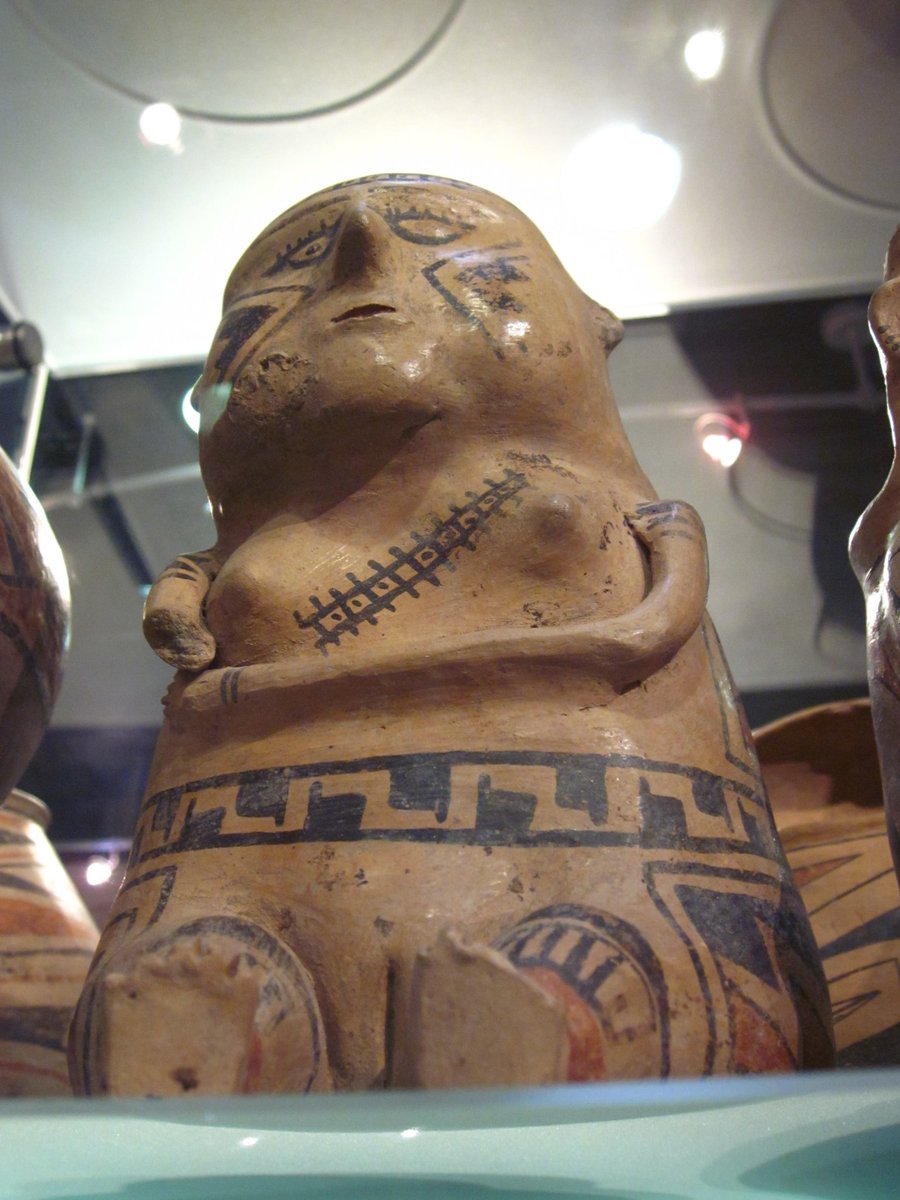Day 13 of #Archaeology31, Gender.
When I realized my identity about two years ago, I returned to thinking about an interest from undergrad; how we study gender in Southwest Archaeology. Often it is through studying art, like this Ramos Polychrome (CE 1250-1450) effigy made...
When I realized my identity about two years ago, I returned to thinking about an interest from undergrad; how we study gender in Southwest Archaeology. Often it is through studying art, like this Ramos Polychrome (CE 1250-1450) effigy made...
...by people of the Casas Grandes Culture of what is now Chihuahua.
Studies of art in archaeology have their issues however. One is mixed samples from museum collections, where provenience can be sketchy, and provenance more so.
There is also the issue of art as...
Studies of art in archaeology have their issues however. One is mixed samples from museum collections, where provenience can be sketchy, and provenance more so.
There is also the issue of art as...
...idealism, where perhaps the art expresses the dominant cultures views on genders, gender roles and gender expression, but not the actual lived experience. Finding out the dominant cultural view still has value, but should it be taken as the final word?
C/W: Mortuary data, mortuary studies
A second area commonly used to explore gender is mortuary data. Particularly by looking at grave goods and sexed skeletons and undertaking a statistical analysis to find if there are significant differences in grave goods by sex.
A second area commonly used to explore gender is mortuary data. Particularly by looking at grave goods and sexed skeletons and undertaking a statistical analysis to find if there are significant differences in grave goods by sex.
For example, are manos and metates more common with females, while weaving tools are more common with males? In this sort of analysis there is always a risk of assuming a task that was gendered now was gendered in the past, but it also can locate "out of place" grave goods.
As a hypothetical example, a skeleton sexed as male, but with manos, metates and a string apron, all associated with women as a gender in Hopi society. Perhaps such an individual was a woman in gender, or belonged to a gender beyond a binary?
The largest issue with such studies is consent and ethics. These of course being very much living peoples ancestors. To satiate curiosity we simply cannot just dig them up and study them.
But in cases where we are allowed, mortuary data can yield intriguing results.
But in cases where we are allowed, mortuary data can yield intriguing results.
Returning to, and ending this thread, on art, I want to cite a few studies and my thoughts on what they achieved.
VanPool and VanPool (2006) used a large sample of Medio Period Casas Grandes effigies such as the one posted here, which displayed sex characteristics (breasts,...
VanPool and VanPool (2006) used a large sample of Medio Period Casas Grandes effigies such as the one posted here, which displayed sex characteristics (breasts,...
...vulva, penis and testicles), looked at activities depicted as being undertaken, posture and painted decoration (VanPool and VanPool 2006:56-70). They found a significant difference in designs and activities between male and female effigies which they interpreted as...
... evidence for a gender binary in the Casas Grandes Culture that was gender complimentary, tied into ritual roles they termed "shamans" and was connected to rising socio-political complexity in an emergent polity (VanPool and VanPool 2006:68-71).
There is however, a massive issue with their sample. Almost all of it is ultimately, without provenience. While it came from both museum and private collections, most of the museum collections used ultimately came from donated, private, pot-hunted contexts (VanPool and...
...VanPool 2006:58-59). Given the high value (though not as high as Mimbres Classic ceramics) of Casas Grandes polychromes on the art market, the lack of provenience and the desireable, graphic nature of the effigies, issues of authenticity should be raised.
This is not to say that all the vessels are fakes, or embellished, but that the possibility exists and should be considered.
To examine this further, one can look at Marit K. Munson's (2000) study of Mimbres gender roles, which was also a mixed sample that often had vessels...
To examine this further, one can look at Marit K. Munson's (2000) study of Mimbres gender roles, which was also a mixed sample that often had vessels...
... lacking provenience. The study found evidence for more than two genders in Mimbres society, but also a strict division of labor along gendered lines.
When a later study using only provenienced vessels was undertaken by Hegmon, McGrath and Munson (2017) these results were...
When a later study using only provenienced vessels was undertaken by Hegmon, McGrath and Munson (2017) these results were...
...not replicated. Rather, the strong statistical evidence for a highly gendered division of labor disappeared, but the evidence for more than two genders remained.
These cases highlight the difficulties in studying gender in the past, a topic I hope to further explore in my...
These cases highlight the difficulties in studying gender in the past, a topic I hope to further explore in my...
...career.
References Cited
Hegmon, Michelle, James R. McGrath and Marit K. Munson
2017 The Potential and Pitfalls of Large Multi-Source Collections. Advances in Archaeological Practice 5(2):1-9.
References Cited
Hegmon, Michelle, James R. McGrath and Marit K. Munson
2017 The Potential and Pitfalls of Large Multi-Source Collections. Advances in Archaeological Practice 5(2):1-9.
Munson, Marit K.
2000 Sex, Gender, and Status: Human Images from the Classic Mimbres. American Antiquity 65(1):127-143.
2000 Sex, Gender, and Status: Human Images from the Classic Mimbres. American Antiquity 65(1):127-143.
VanPool, Christine S. and Todd L. VanPool
2006 Gender in Middle Range Societies: A Case Study in Casas Grandes Iconography. American Antiquity 71(1):53-75.
2006 Gender in Middle Range Societies: A Case Study in Casas Grandes Iconography. American Antiquity 71(1):53-75.

 Read on Twitter
Read on Twitter


